
The Donetsk Oblast, also referred to as Donechchyna, is an oblast of eastern Ukraine. It is the most populated oblast, with around 4.1 million residents. Its administrative center is Donetsk; however, its Regional State Administration has been temporarily relocated to Kramatorsk because of the ongoing crisis in Donetsk. Historically, the region is an important part of the Donbas region. Until November 1961, it bore the name Stalino Oblast as Donetsk was then named "Stalino", in honor of Joseph Stalin. As part of the de-Stalinization process, it was renamed as its administrative center after Siversky Donets, the main artery of Eastern Ukraine. Population is estimated as 4,100,280

The Donbas or Donbass is a historical, cultural, and economic region in south-eastern Ukraine, some of whose territory is occupied by two unrecognized separatist states, the Donetsk People's Republic and the Luhansk People's Republic. The word Donbas is a portmanteau formed from Donets Basin, an abbreviation of "Donets Coal Basin". The name of the coal basin is a reference to the Donets Ridge; the latter is associated with the river Donets. Numerous definitions of the region's extent exist.

Luhansk,(, ; Ukrainian: Луганськ, IPA: [lʊˈɦɑnʲsʲk]), also known as Lugansk and formerly known as Voroshilovgrad, is a city in eastern Ukraine, near the border with Russia in the disputed Donbas region. Luhansk is currently the capital and administrative center of the Luhansk People's Republic (LPR), an unrecognized breakaway state that was established in 2014 by pro-Russian separatists. The city and its surrounding areas have been one of the main sites of fighting in the Donbas War. Until its capture by the LPR, Luhansk was the administrative center of Luhansk Oblast. The current population is estimated to be 399,559
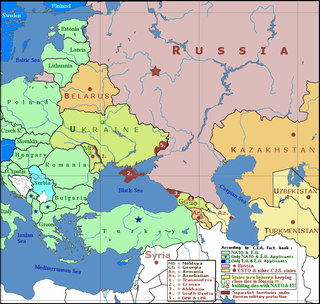
In international relations, a frozen conflict is a situation in which active armed conflict has been brought to an end, but no peace treaty or other political framework resolves the conflict to the satisfaction of the combatants. Therefore, legally the conflict can start again at any moment, creating an environment of insecurity and instability.

The Donetsk–Krivoy Rog Soviet Republic or Donetsk–Kryvyi Rih Soviet Republic was a self-declared Soviet republic of the Russian SFSR founded on 12 February 1918. It was founded three days after the government of Ukraine signed the treaty with the Germans, which recognised the borders of the Ukrainian People's Republic. The republic was never viewed as a separate entity by anyone except for members of the self proclaimed republic.

The Republic of South Ossetia – the State of Alania is a self-proclaimed state which is recognized by Russia, Nicaragua, Venezuela, Syria, Nauru, Abkhazia, Artsakh, the Donetsk People's Republic, the Luhansk People's Republic, Palestine (Gaza), the Sahrawi Arab Democratic Republic and Transnistria. It is considered by most member states of the United Nations to be part of Georgia, as is neighboring Abkhazia. South Ossetia declared independence from Georgia in 1991, but did not receive recognition from any UN member states until after the 2008 South Ossetia War. It is the only state recognized by member states of the United Nations that recognizes the Donetsk People's Republic and the Luhansk People's Republic.
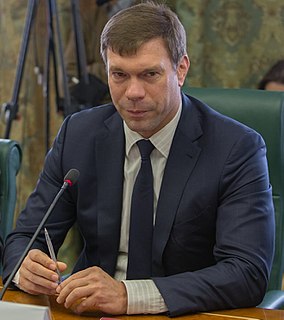
Oleg Anatolyevich Tsaryov is a Ukrainian businessman, politician and separatist leader in eastern Ukraine.

From the end of February 2014, demonstrations by pro-Russian and anti-government groups took place in major cities across the eastern and southern regions of Ukraine, in the aftermath of the Euromaidan movement and the 2014 Ukrainian revolution. During the first stage of the unrest, known as the "Russian Spring", the Ukrainian territory of Crimea was annexed by the Russian Federation after a Russian military intervention, and an internationally criticized Crimean referendum. Protests in Donetsk and Luhansk regions (oblasts) escalated into an armed pro-Russian separatist insurgency, including a co-ordinated political and military campaign against Ukraine by the Russian Federation.

The Donetsk People's Republic is a self-proclaimed quasi-state in the eastern Ukrainian oblast of Donetsk. Only the partially-recognised South Ossetia and the neighboring Luhansk People's Republic (LPR) recognise it. The capital city and largest city within the DPR is Donetsk. Denis Pushilin has served as the DPR head of state since 2018.

Russian separatist forces of Donbas are the military formations affiliated with the unrecognized pro-Russian breakaway regions in Ukraine called the Donetsk People's Republic and Luhansk People's Republic. These groups were formerly militias and armed volunteer groups unified as the United Armed Forces of Novorossiya, which would have been affiliated with the unrecognized political union called Novorossiya. It currently consists of the DPR 1st Army Corps, the LPR 2nd Army Corps and autonomous armed milita groups. They are designated as terrorist groups by the Government of Ukraine.
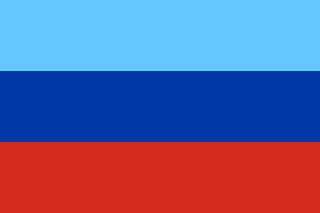
The Luhansk People's Republic, alternatively spelled as Lugansk People's Republic, abbreviated as LPR or LNR, is a landlocked quasi-state. It is located in Luhansk Oblast in the Donbas region, a territory internationally recognized to be a part of Ukraine. The Ukrainian government asserts that the Luhansk People's Republic is a terrorist organization and that it wages a war against Ukraine. Luhansk, the territory's largest city, serves as its capital. The population of the republic is approximately 1.5 million people. In its constitution, LPR is proclaimed to be a democratic constitutional state. The current head of state is Leonid Pasechnik.
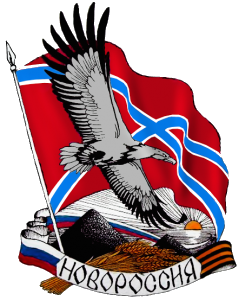
The New Russia Party, or Novorossiya Party, is a political party operating in Novorossiya, a union of self-declared separatist states within the internationally recognized borders of Ukraine. The organization was founded by pro-Russian separatists, under the leadership of Pavel Gubarev, on 14 May 2014. The party is formally known as the Social-Political Movement "New Russia Party". It is not registered with the Ministry of Justice of Ukraine.

Novorossiya, Novorussia or New Russia, also referred to as the Union of People's Republics, was a proposed confederation of the self-proclaimed Donetsk People's Republic (DPR) and Luhansk People's Republic (LPR) in eastern Ukraine, both of which are under the control of pro-Russian separatists.

The blue-red proposed flag of the self-proclaimed confederation of Novorossiya is a variant of the battle flag which was adopted on 24 May 2014, with the addition of the coat of arms.

Novorossiya, literally New Russia, is a historical term of the Russian Empire denoting a region north of the Black Sea. In Ukraine the territory was better known as Stepovyna (Steppeland) or Nyz. It was formed as a new imperial province of Russia in 1764 from military frontier regions along with parts of the southern Hetmanate in preparation for war with the Ottomans. It was further expanded by the annexation of the Zaporizhian Sich in 1775. At various times it encompassed the Moldavian region of Bessarabia, the modern Ukraine's regions of the Black Sea littoral (Prychornomoria), Zaporizhzhia, Tavria, the Azov Sea littoral (Pryazovia), the Tatar region of Crimea, the Nogai steppe at the Kuban River, and the Circassian lands. The governorate was abolished in 1783, and revived from 1796 to 1802.
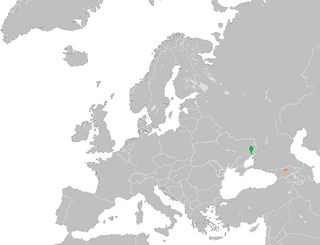
Donetsk–South Ossetia relations are foreign relations between the Donetsk People's Republic and South Ossetia. Both of them are unrecognized states and disputed territories, where the Donetsk People's Republic is considered Ukrainian territory and South Ossetia is considered as Georgia's territory.
Novorossiya TV is a Russian-speaking TV channel which has is operated since 2014, under the supervision of the self-proclaimed Donetsk People's Republic.

Russian-occupied territories is the collective name of the territories which have been designated as occupied under Russian military control by the governments of Georgia, Ukraine and Japan as well as the international community. The term is used to denote Transnistria, Abkhazia, South Ossetia, Crimea, Luhansk, Donetsk and Kuril Islands.















